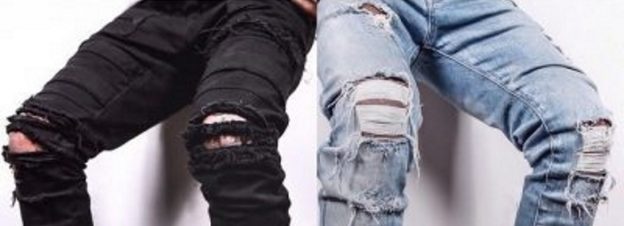It’s no secret that for many Japanese jeans fans, raw or dry denim, stands to be the most interesting and coveted factors of all. The idea of jeans in its “primordial form” attracts people by its variability, individuality, and originality, while the ability to create your own “denim story” is probably the most fun process, watching your dark blue jeans change from month to month.
However, it is worth noting that the Japanese denim tradition is not only limited to untouched raw denim. Jeans that are post-processed are a product of a long and laborious work, where the construction of every ready-made pair of jeans is no less important than weaving or sewing production. There can be no talk of mass production here, as each pair gets its own personalization, not unlike the “drawing” hands of a master.
Yet, as soon as people hear about denim with artificial post-processing, many turn a cold shoulder. But this turns out to be nothing more than an established stereotype. Not to point fingers, mass denim heaps of jeans are the culprit that we can find in any shopping mall out there. Chaotically applied rubbing, distressed elements, and acid etching, give off fake and cringy vibes of an ugly and unnatural work– And henceforth determine itself to be a poor-quality “source product”.
What’s Special with Distressed Jeans?
Distinguish yourself from the riffraff- embrace and understand what makes distressed jeans so unique. And what better place to start than from the original manufacturers? First, Japanese companies specializing in the production of quality jeans from untreated denim are the undisputed leader. In addition to the authentic models, these old-timers have also perfected and produced excellent models with post-processing. These jeans, in any case, shouldn’t be less appreciated than classics from raw denim. On the contrary, good jeans with artificial attrition will harmoniously complement your denim collection 🙂 In the end, for sure, each of us would like to know what our jeans would look like when they are worn down to a practically dilapidated state. Repair them and wear again? Not all jeans are to be worn to such an “extreme” state in a natural way. (It takes a lot of patience, and who has the time?) So, why not take a truthful shortcut and try this kind of denim- even out of curiosity?
The easiest version of post-processing is to just wash your denim with stones (Stonewash). On the jeans, the seams will clearly appear and the denim will be lighter. The processing of denim with emery paper makes it possible to apply an artificial “pattern” in the form of contrasting abrasions that accurately simulate the natural wear process. Handling pockets and the bottom of the pants gives jeans an even more worn look. An additional application of special patches, hand stitches, zigzag stitches gives jeans the look of a vintage thing from the past after wear and time. In short:
– A lot of jeans manufacturers from dry denim, make very good quality distressed jeans
– Postprocessing is a very long process that requires responsibility and attention to detail. It is performed by real masters, for which denim is like a canvas for an artist
– All distressed elements are executed manually or with minimal use of automation
– Properly applied post-processing bears great resemblance a pair of experienced, worn-out jeans. Elements such as whiskers (rubbing on the folds in the hips), honeycombs (knee-like deformities resembling bees’ honeycombs), are always in their place and will look natural.
– These jeans do not require pre-shrinkage and long wear, they are comfortable as soon as you get them out of the bag
– All decorative distressed items are made in such a way that the jeans do not tear further. Despite the shabby appearance, such things are strong and reliable
– With proper care, these jeans will last you a long time and will please you for a great deal longer than that!
Here are a few examples of such jeans that Denimio has:

Here we see a relatively delicate kind of post-processing. The main idea of this model is the contrast between wiped and unburnt part of denim.

The fade you get with using sandpaper believably simulates the look of a long time worn out jeans. To give a more “vintage” look, the pockets and edges of the pants are additionally processed.

Like the previous one, this model has a fairly accurate and realistic post processing. Jeans are processed over the entire surface. The parts where the wear should be more noticeable are highlighted carefully.

In this model, post-processing is performed in a more radical way. These are the so-called remake jeans. In addition to treating the denim surface with emery and processing the edges of the pockets, distressed elements are also present on the legs. Cross sections of the fabric are specially processed, soft material for patches is put under them, then it is gently dug.

Here you will definitely think of old vintage jeans that were previously worn to the limit and repaired.

Denim of these jeans also initially breaks in many places, then patches are put on jeans. However, unlike the previous model, another technique is used here. The cloth is not put on the inside but on the outside.

Here you can clearly see the technique of remake jeans from the patriarchs of Japanese denim, Studio D’Artisan.
The basis is taken from the wiped jeans, which already have highlights. Transverse tears are made on the trousers, then patches are patched on the back side and stitched with transverse stitches. In addition, the contour of the patch is additionally spread around the perimeter.

Jeans with a little less radical treatment. Here, the effect of long-worn jeans with pronounced fading has been created, which has already been repaired manually with patches.

Jeans from Japan Blue are a light 10OZ great option for the summer. To give a more relaxed image to the pre-washed denim, artificial patches and stitches are applied.

As well as the previous model, these are light jeans for warm weather. Here, the 10OZ denim is used, with small artificial shades and a light blue hue.

Here we have an even easier version of post processing. The dark washed denim has only very little shabbiness, which looks quite natural.

Trendy narrowed jeans from FOB Factory with the addition of elastane have a denim of low density with a light tint and small, but noticeable erosion.

Jeans made of rubbed denim. The rubs simulate the look of the jeans, which have been worn out for about one year. A special feature of the Hand Room jeans is also the use of the long-fiber Supima cotton, which gives the material characteristics of softness and comfort.

These jeans from Hosu have an even deeper contrast. Thanks to all the same processing of jeans by hand, the effect of a 4-year-old worn jeans is achieved.

For this model, the masters at the company Hosu created an image of very old vintage jeans that were worn for about 15 years. Here, many kinds of processing are used- apart from emery rubbers, they have transverse distressed elements.

An excellent option for those who prefer the light color of light indigo. A 13OZ washed denim is used, which has artificial attrition but does not have distressed elements.
Recommendations for choosing distressed denim jeans.
- When choosing a size, try very carefully to choose by taking the length into account. The application of artificial rubbing makes each pair completely finished. Using hemming service, shortening jeans along the length here is almost impossible.
Here are some recommendations to take good care of distressed denim jeans
- Try to avoid aggressive machine washing
- Try not to use spinning in the washing machine with high speed (jeans can be damaged in places of “artificial rips”)
- Do not use detergents with bleach (this is the rule for both dry denim and distressed denim)
- Before washing, always turn the jeans inside out and fasten all buttons or zippers
Think Blue. Think Denimio.


